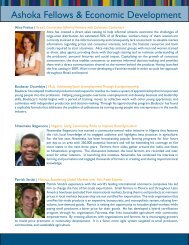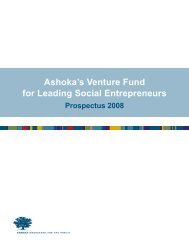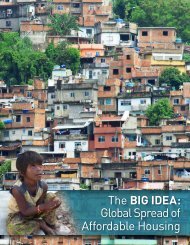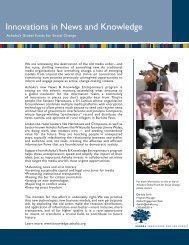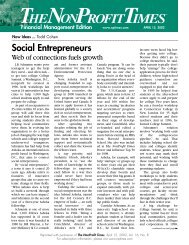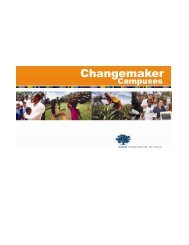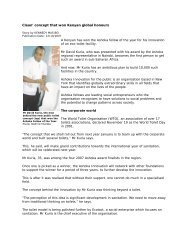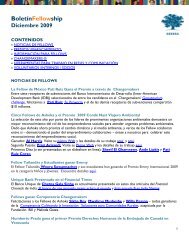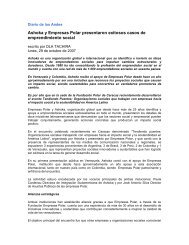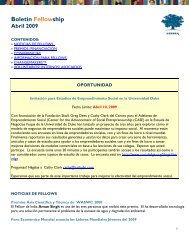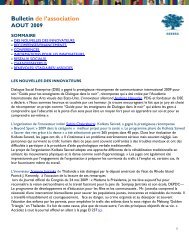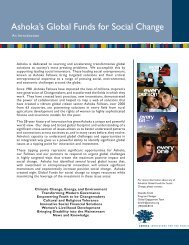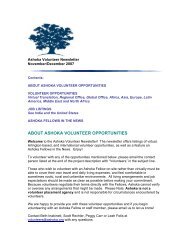Access to Energy for the Base of the - Ashoka
Access to Energy for the Base of the - Ashoka
Access to Energy for the Base of the - Ashoka
Create successful ePaper yourself
Turn your PDF publications into a flip-book with our unique Google optimized e-Paper software.
78<br />
The four groups <strong>of</strong> business models discussed above<br />
describe <strong>the</strong> spectrum <strong>of</strong> opportunities that have shown<br />
promise in terms <strong>of</strong> access <strong>to</strong> energy <strong>for</strong> <strong>the</strong> BOP.<br />
However, <strong>the</strong>se businesses will remain modest in <strong>the</strong>ir<br />
impact if <strong>the</strong>y lack an enabling ecosystem. Primary<br />
among <strong>the</strong> gaps in this ecosystem is financing. Although<br />
o<strong>the</strong>r fac<strong>to</strong>rs such as government relationships or skilled<br />
staff make a difference, access <strong>to</strong> financing is a strong<br />
determining fac<strong>to</strong>r in <strong>the</strong> growth <strong>of</strong> energy enterprises.<br />
Almost all energy enterprises pr<strong>of</strong>iled required grants or<br />
subsidized capital, at least in <strong>the</strong> early stages. The launch<br />
<strong>of</strong> access <strong>to</strong> energy enterprises targeting <strong>the</strong> BOP will<br />
depend on low-cost capital <strong>for</strong> <strong>the</strong> <strong>for</strong>eseeable future.<br />
Sources <strong>of</strong> financing and financial intermediaries <strong>for</strong><br />
this market are becoming increasingly more available;<br />
<strong>the</strong> diversity <strong>of</strong> <strong>the</strong>se financial ac<strong>to</strong>rs indicates a wellfought<br />
maturity in <strong>the</strong> access <strong>to</strong> energy market and a<br />
readiness <strong>to</strong> support new entrants. Un<strong>for</strong>tunately, high<br />
hopes <strong>for</strong> carbon markets that serve low-income people<br />
have failed <strong>to</strong> materialize. Significant barriers remain <strong>for</strong><br />
small clean energy enterprises that wish <strong>to</strong> access<br />
carbon finance, and most do so in <strong>the</strong> end through<br />
voluntary markets ra<strong>the</strong>r than <strong>the</strong> UN-regulated system.<br />
Financing <strong>for</strong> access <strong>to</strong> energy can be split in<strong>to</strong> three<br />
categories:<br />
1. Grant-based support <strong>to</strong> build <strong>the</strong> market<br />
2. Patient capital with energy expertise<br />
3. Carbon markets designed <strong>to</strong> serve low-income<br />
communities<br />
Figure 18 E + Co’s portfolio around <strong>the</strong> world<br />
Grant-based support <strong>to</strong> build<br />
<strong>the</strong> market<br />
Building a new market involves an immense amount<br />
<strong>of</strong> uncertainty, and an expensive outlay <strong>for</strong> research,<br />
development <strong>of</strong> regulation, and educating consumers,<br />
among o<strong>the</strong>r things. For example, solar home system<br />
entrepreneurs first had <strong>to</strong> help households gain<br />
confidence that it is possible <strong>to</strong> get electricity from<br />
<strong>the</strong> sun. Cooks<strong>to</strong>ve enterprises had <strong>to</strong> test <strong>the</strong>ir<br />
s<strong>to</strong>ves and teach people about <strong>the</strong> dangers <strong>of</strong> indoor<br />
air pollution. Provivienda worked out a new<br />
arrangement that would allow households without<br />
<strong>for</strong>mal land title <strong>to</strong> receive a gas connection. These<br />
are time-consuming endeavors that will be beneficial<br />
<strong>for</strong> all subsequent enterprises. In a sense, <strong>the</strong>y are<br />
market-building public goods. Purely commercial<br />
enterprises are poorly suited <strong>to</strong> take on this role. The<br />
access <strong>to</strong> energy market benefits from dedicated<br />
foundations such as Winrock International and<br />
dedicated multilateral programs at <strong>the</strong> World Bank<br />
and IFC.<br />
In September 2007 <strong>the</strong> World Bank and <strong>the</strong> IFC<br />
announced <strong>the</strong> Lighting Africa program, dedicated <strong>to</strong><br />
bringing clean lighting <strong>to</strong> 250m people in Africa. 17<br />
Initial programs include a design competition, market<br />
research, and a business-<strong>to</strong>-business web portal.<br />
Although <strong>the</strong> IFC had struggled <strong>to</strong> dispense <strong>the</strong> funds<br />
allocated <strong>to</strong> its solar PV market-building funds,<br />
financiers are learning from <strong>the</strong> past. 18 For example,<br />
<strong>the</strong> African Rural <strong>Energy</strong> Enterprise Development<br />
(AREED) program has invested $4.3m in clean energy<br />
enterprises in Africa, generating a 2% - 6% risk<br />
adjusted return. The program has been replicated in<br />
Brazil and China.<br />
17 O<strong>the</strong>r sponsors include Global Environment Facility, <strong>the</strong> <strong>Energy</strong> Sec<strong>to</strong>r Management Assistance Programme, Public Private Infrastructure Advisory Facility, <strong>the</strong><br />
European Commission, Governments <strong>of</strong> Norway, Luxembourg and Sweden, Good Energies Inc., and <strong>the</strong> Renewable <strong>Energy</strong> and <strong>Energy</strong> Efficiency Partnership<br />
18 Selling Solar Part I; IFC



